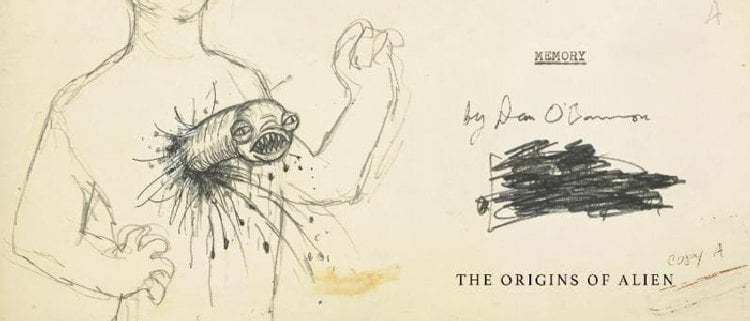Memory: The Origins of Alien

There are films that have an influence on people that spans generations. “Alien (1979)” is one of those films. But, where did all of that staying power come from? Documentary filmmaker Alexandre O. Philippe delves into this very subject in “Memory: The Origins of Alien.”
Laura's Review: B
Forty years ago, posters for a sci-fi/horror hybrid warned us that ‘in space no one can hear you scream.’ Writer/director Alexandre O. Philippe (“78/52: Hitchcock’s Shower Scene”) takes a deep dive into just what went into the making of this classic, one which spawned a franchise that is still going strong, in “Memory: The Origins of Alien.”
And with that subtitle it is no surprise that a lot of the inspiration for “Alien” came from author Dan O’Bannon’s childhood. O’Bannon passed away ten years ago (notably from Crohn's disease), but his wife Diane, who calls him an iconoclast, is on hand to recall how he was fascinated with cicadas, which come out of the ground after ten years and were the inspiration for the alien eggs. He talked UFO landings with his dad and loved Lovecraft, whose ‘At the Mountains of Madness’s’ fossilized remains became the ‘the old ones.’ And old 1951 EC Comics’ title ‘Seeds of Jupiter’ featured men isolated on an aircraft carrier tricked into eating seed which spawn octopus-like creatures which burst forth from their abdomens. A number of Roger Corman films all had their influences, but the man’s biggest contribution may have been advising O’Bannon to go for a bigger budget than he could provide for the screenplay then known as ‘Star Beast’ while still offering to make it if O’Bannon could not find funding elsewhere.
But as much as O’Bannon’s memory was responsible for this classic, it was also blessed with a confluence of events, like Jodorowsky tapping him for his never-made “Dune,” the project which exposed him to H.R. Giger. Director Ridley Scott completed the trinity, fighting the studio for the budget to hire Giger and to create the huge space jockey.
Philippe stuffs his documentary with all sorts of imagery from Francis Bacon paintings to the Egyptian art Giger turned to, often tiling them within his frame for a 3D effect. The film’s male rape and impregnation subtext has a new light shone with analysis of the alien as mythological Fury seeking vengeance for the repression of women. The documentary goes much further than the ‘film school extras’ found on laserdiscs and blu-rays. Best of all it will inspire you to go back and watch a classic again.
Robin's Review: B-
The filmmaking team of “Memory” starts things off with the images of the Temple of Apollo in Delphi to begin this analysis of the making of “Alien.” Dan O’Bannon, the creator of the story, was influenced by 1950s bug movies like “Them (1945)” and monster movies like “It! (1958),” “The Thing (from Another World (1951) and Roger Corman’s “Queen of Blood (1966),” showing how those and other movies influenced the story that would become a classic.
The “Alien” fable, though unoriginal in concept, excels because of the monster art design by H.R. Giger, which, I think, made “Alien” what it would become in our pop culture. Director Phillipe describes the genesis of “Alien” with its early days before Ridley Scott and company got involved. Walter Hill, we learn, was attached to the production, as was Giger, and the embryo of the later film was conceived.
Director-writer Philippe assembles story notes, designs and storyboards – both rejected and accepted – interviews with cast members Tom Skerritt and Veronica Cartwright (Though no other members, like Sigourney Weaver), interviews including Alien writer Dan O’Bannon’s wife Diane and the original 29-page script. This first half of the documentary is woven well and provides a lot of pre-and-post ”Alien” information.
The second half of “Memory” is solely focused on the infamous alien-creature-bursting-out-of-the-chest-of-Kane (John Hurt) scene. You, know, the one that we have all seen a zillion times over the years. While interesting enough, the in-depth analysis of this one scene, gets tedious and lacks the tightness of the film’s first half.

